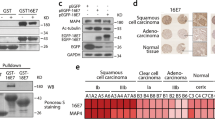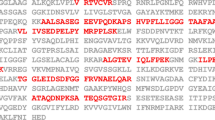Abstract
In this study we show that E6 of human papillomavirus has the ability to deregulate the cell cycle G1/S transition. In rodent immortalized fibroblasts (NIH3T3) serum deprivation or over-expression of the cyclin-dependent kinase inhibitors, p16INK4a or p27KIP1, leads to G1 cell cycle arrest. HPV16 E6 overcomes the antiproliferative signals, gaining the ability to drive serum-deprived and p16INK4a or p27KIP1 over-expressing cells into S phase. E6 protein from the benign HPV type 1 displays a similar activity to HPV16 E6 to deregulate the G1/S transition. Thus, this activity appears to be conserved between E6 proteins from non-oncogenic and oncogenic HPV types. Furthermore, we show that HPV16 E6 is not able to circumvent a G1 arrest imposed by pRb mutant in which all CDK phosphorylation sites have been mutated. These data indicate that the viral protein acts upstream of pRb and its mechanism in promoting cell cycle progression is dependent on pRb phosphorylation. In summary, this study describes a novel biological function of HPV E6 and shows that the S phase entry, required for viral DNA replication, is not exclusively controlled by E7, but that E6 also is involved in this event.
This is a preview of subscription content, access via your institution
Access options
Subscribe to this journal
Receive 50 print issues and online access
$259.00 per year
only $5.18 per issue
Buy this article
- Purchase on Springer Link
- Instant access to full article PDF
Prices may be subject to local taxes which are calculated during checkout







Similar content being viewed by others
References
Alevizopoulos K, Vlach J, Hennecke S, Amati B . 1997 EMBO J. 16: 5322–5333
Alunni-Fabbroni M, Littlewood T, Deleu L, Caldeira S, Giarre M, Dell'Orco M, Tommasino M . 2000 Oncogene 19: 2277–2285
Botz J, Zerfass-Thome K, Spitkovsky D, Delius H, Vogt B, Eilers M, Hatzigeorgiou A, Jansen-Dürr P . 1996 Mol. Cell. Biol. 16: 3401–3409
Boyer SN, Wazer DE, Band V . 1996 Cancer Research 56: 4620–4624
Caldeira S, de Villiers EM, Tommasino M . 2000 Oncogene 19: 821–826
Ciccolini F, Di Pasquale G, Carlotti F, Crawford L, Tommasino M . 1994 Oncogene 9: 2342–2348
Dyson N, Howley PM, Munger K, Harlow E . 1989 Science 243: 934–937
Elbel M, Carl S, Spaderna S, Iftner T . 1997 Virology 239: 132–149
Gage JR, Meyers C, Wettstein FO . 1990 J. Virol. 64: 723–730
Giarrè M, Caldeira S, Malanchi I, Ciccolini F, Leão MJ, Tommasino M . 2001 J. Virol. 75: 4705–4712
Jones DL, Munger K . 1997 J. Virol. 71: 2905–2912
Lukas J, Herzinger T, Hansen K, Moroni MC, Resnitzky D, Helin K, Reed SI, Bartek J . 1997 Genes Dev. 11: 1479–1492
Lukas J, Parry D, Aagaard L, Mann DJ, Bartkova J, Strauss M, Peters G, Bartek J . 1995 Nature 375: 503–506
Mann DJ, Jones NC . 1996 Curr. Biol. 6: 474–483
Martin LG, Demers GW, Galloway DA . 1998 J. Virol. 72: 975–985
Morgenstern JP, Land H . 1990 Nucleic Acids Res. 18: 3587–3596
Morris EJ, Dyson NJ . 2001 Adv. Cancer Res. 82: 1–54
Munger K, Werness BA, Dyson N, Phelps WC, Harlow E, Howley PM . 1989 EMBO J. 8: 4099–4105
Pear WS, Nolan GP, Scott ML, Baltimore D . 1993 Proc. Natl. Acad. Sci. USA 90: 8392–8396
Schmitt A, Harry JB, Rapp B, Wettstein FO, Iftner T . 1994 Journal of Virology 68: 7051–7059
Schulze A, Zerfaß K, Spitkovsky D, Berges J, Middendorp S, Jansen-Dürr P, Henglein B . 1995 Proc. Natl. Acad. Sci. USA 92: 11264–11268
Serrano M, Lin AW, McCurrach ME, Beach D, Lowe SW . 1997 Cell 88: 593–602
Sherr CJ, Roberts JM . 1999 Genes Dev. 13: 1501–1512
Thomas M, Pim D, Banks L . 1999 Oncogene 18: 7690–7700
Tommasino M, Jansen-Dürr P . 1997 E7 protein. ‘Human papillomaviruses in human cancer: the role of E6 and E7 oncoproteins’ Austin, USA: R.G. Landes Company
Vlach J, Hennecke S, Alevizopoulos K, Conti D, Amati B . 1996 EMBO J. 15: 6595–6604
Zerfass K, Schulze A, Spitkovsky D, Friedman V, Henglein B, Jansen-Dürr P . 1995 J. Virol. 69: 6389–6399
Zerfass-Thome K, Zwerschke W, Mannhardt B, Tindle R, Botz J, Jansen-Dürr P . 1996 Oncogene 13: 2323–2330
zur Hausen H . 2000 J. Natl. Cancer Instit. 92: 690–698
Zwerschke W, Jansen-Durr P . 2000 Adv. Cancer Res. 78: 1–29
Acknowledgements
We are grateful to Professors Harald zur Hausen and Lutz Gissmann for their continuous support and interest in our work. We would also like to thank all the members of our laboratory for their co-operation, Drs Bruno Amati, Jiri Bartek, Michele Pagano and Gordon Peters for antibodies or DNA constructs, Drs Werner Rittgen and Lutz Edler for statistical analysis and Dr Leonie Ringrose for critical reading of the manuscript. S Caldeira was supported by a PRAXIS XXI doctoral fellowship (Sub Programa Ciencia e Tecnologia do 2° Quadro Comunitario de Apoio).
Author information
Authors and Affiliations
Corresponding author
Rights and permissions
About this article
Cite this article
Malanchi, I., Caldeira, S., Krützfeldt, M. et al. Identification of a novel activity of human papillomavirus type 16 E6 protein in deregulating the G1/S transition. Oncogene 21, 5665–5672 (2002). https://doi.org/10.1038/sj.onc.1205617
Received:
Revised:
Accepted:
Published:
Issue Date:
DOI: https://doi.org/10.1038/sj.onc.1205617
Keywords
This article is cited by
-
Cyclin A1 shows age-related expression in benign tonsils, HPV16-dependent overexpression in HNSCC and predicts lower recurrence rate in HNSCC independently of HPV16
BMC Cancer (2012)
-
Restoration of tumor suppressor p53 by differentially regulating pro- and anti-p53 networks in HPV-18-infected cervical cancer cells
Oncogene (2012)
-
The biological properties of E6 and E7 oncoproteins from human papillomaviruses
Virus Genes (2010)
-
RETRACTED ARTICLE: Human papillomavirus type 77 E6 protein selectively inhibits p53-dependent transcription of proapoptotic genes following UV-B irradiation
Oncogene (2004)



